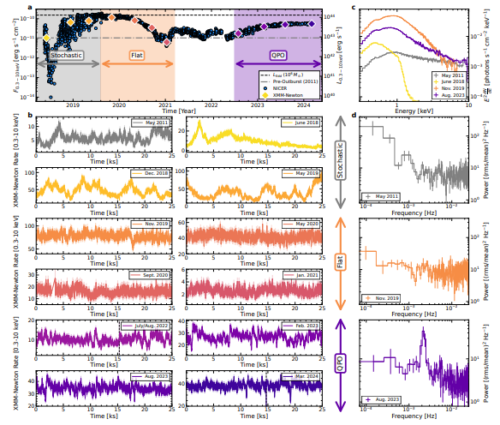2025-01-13 マサチューセッツ工科大学
<関連情報>
- https://news.mit.edu/2025/x-ray-flashes-nearby-supermassive-black-hole-accelerate-mysteriously-0113
- https://arxiv.org/abs/2501.01581
超巨大ブラックホールの最周回軌道近傍でミリヘルツ振動が観測される Millihertz Oscillations Near the Innermost Orbit of a Supermassive Black Hole
Megan Masterson, Erin Kara, Christos Panagiotou, William N. Alston, Joheen Chakraborty, Kevin Burdge, Claudio Ricci, Sibasish Laha, Iair Arcavi, Riccardo Arcodia, S. Bradley Cenko, Andrew C. Fabian, Javier A. García, Margherita Giustini, Adam Ingram, Peter Kosec, Michael Loewenstein, Eileen T. Meyer, Giovanni Miniutti, Ciro Pinto, Ronald A. Remillard, Dev R. Sadaula, Onic I. Shuvo, Benny Trakhtenbrot, Jingyi Wang
arXiv Submitted on 3 Jan 2025
DOI:https://doi.org/10.48550/arXiv.2501.01581

Abstract
Recent discoveries from time-domain surveys are defying our expectations for how matter accretes onto supermassive black holes (SMBHs). The increased rate of short-timescale, repetitive events around SMBHs, including the newly-discovered quasi-periodic eruptions (QPEs), are garnering further interest in stellar-mass companions around SMBHs and the progenitors to mHz frequency gravitational wave events. Here we report the discovery of a highly significant mHz Quasi-Periodic Oscillation (QPO) in an actively accreting SMBH, 1ES 1927+654, which underwent a major optical, UV, and X-ray outburst beginning in 2018. The QPO was first detected in 2022 with a roughly 18-minute period, corresponding to coherent motion on scales of less than 10 gravitational radii, much closer to the SMBH than typical QPEs. The period decreased to 7.1 minutes over two years with a decelerating period evolution (P¨>0). This evolution has never been seen in SMBH QPOs or high-frequency QPOs in stellar mass black holes. Models invoking orbital decay of a stellar-mass companion struggle to explain the period evolution without stable mass transfer to offset angular momentum losses, while the lack of a direct analog to stellar mass black hole QPOs means that many instability models cannot explain all of the observed properties of the QPO in 1ES 1927+654. Future X-ray monitoring will test these models, and if it is a stellar-mass orbiter, the Laser Interferometer Space Antenna (LISA) should detect its low-frequency gravitational wave emission.


